What Size Brake Line Do I Need
To determine the size brake line you need, measure the diameter of your current brake line. Brake lines commonly range from 3/16 inch to 1/4 inch in diameter.
You can also refer to your vehicle’s manual for specific sizing information. Ensuring the correct size brake line is essential for efficient and safe braking performance. Upgrading or replacing the brake lines can improve braking responsiveness and overall driving safety.
Properly sized brake lines help maintain optimal hydraulic pressure, preventing leaks and ensuring reliable brake system operation. Remember, always consult with a professional if you are unsure about the correct size for your vehicle.
Choosing The Right Brake Line Size
When it comes to the braking system of your vehicle, selecting the right brake line size is crucial for ensuring optimal performance and safety. Understanding brake line sizing and the factors to consider when selecting the appropriate size can help you make an informed decision. Let’s delve deeper into the process of choosing the right brake line size.
Understanding Brake Line Sizing
Brake line sizing refers to the diameter of the brake line used in a vehicle’s hydraulic brake system. This sizing is typically denoted in fractions of an inch, such as 1/4”, 3/16”, or 4.75mm, and plays a significant role in determining the brake system’s hydraulic pressure and fluid volume capacity.
Factors To Consider When Selecting Brake Line Size
- Vehicle Type: Consider the make and model of your vehicle when determining the appropriate brake line size. Larger and heavier vehicles may require thicker brake lines to accommodate the braking demands.
- Brake System Configuration: Evaluate the brake system configuration of your vehicle, whether it’s equipped with standard or performance brakes, as this can impact the required brake line size.
- Regulatory Standards: Ensure that the chosen brake line size complies with applicable regulations and standards to guarantee safety and legal compliance.
- Operating Conditions: Take into account the operating conditions of the vehicle, including temperature variations and load capacities, which may necessitate specific brake line sizing to ensure reliable braking performance.
- Material Compatibility: Consider the compatibility of the brake line size with the brake fluid and the material construction of the brake lines to prevent corrosion and ensure longevity.

Credit: www.fedhillusa.com
Measuring Brake Line Size
Ensuring you have the correct size brake line is crucial for the safety and performance of your vehicle. Measuring brake line size accurately is necessary before any brake line installation or replacement.
Tools Needed For Measuring Brake Line Size
To accurately measure your brake line size, you will need the following tools:
- Calipers or a ruler with metric and standard measurements
- Clean cloth to wipe off any grease or dirt
Step-by-step Guide To Measuring Brake Line Size
- Locate the brake line you wish to measure
- Clean the brake line with a cloth to remove any debris
- Using calipers or a ruler, measure the outer diameter of the brake line
- Take note of the measurement in both metric and standard units
- Verify the measurements to ensure accuracy
Common Brake Line Sizes
When selecting the right brake line size, it’s crucial to be aware of the common options available. Understanding the Common Brake Line Sizes will help you make an informed decision for your vehicle.
Overview Of Brake Line Diameter Options
Brake lines come in various diameters to suit different vehicles and systems. The most common brake line diameters you’ll encounter include:
- 3/16 inch: Widely used for most automotive brake systems.
- 1/4 inch: Commonly found in larger vehicles like trucks and SUVs.
- 5/16 inch: Often used for heavy-duty applications like commercial trucks.
Popular Brake Line Size Recommendations
Based on industry standards and vehicle requirements, here are some popular brake line size recommendations:
| Vehicle Type | Recommended Brake Line Size |
|---|---|
| Compact Cars | 3/16 inch |
| Sedans and Crossovers | 3/16 inch |
| Trucks and SUVs | 1/4 inch |
| Commercial Vehicles | 5/16 inch |
Choosing Brake Line Material
When it comes to choosing the right brake line material, it is important to consider various factors that can affect the performance and durability of your brake system. The material of the brake line plays a significant role in ensuring the safety and efficiency of your vehicle’s braking system. Factors such as corrosion resistance, tensile strength, and flexibility need to be taken into account when selecting the most suitable brake line material for your specific needs.
Pros And Cons Of Different Brake Line Materials
Each type of brake line material comes with its own set of advantages and disadvantages, making it crucial to weigh the pros and cons based on your vehicle’s requirements. Here’s a breakdown of some common brake line materials:
| Material | Pros | Cons |
|---|---|---|
| Steel | High tensile strength, durable | Susceptible to rust and corrosion |
| Stainless Steel | Excellent corrosion resistance | More expensive than other materials |
| Copper-Nickel | Outstanding corrosion resistance, easy to bend and flare | Less common, higher cost |
Considerations For Selecting Brake Line Material
Before settling on a specific brake line material, it’s essential to consider the following factors:
- Corrosion Resistance: Prioritize materials with high resistance to corrosion to ensure longevity.
- Tensile Strength: Opt for materials with sufficient strength to withstand the brake system’s pressure.
- Flexibility: Choose a material that offers ease of bending and forming for installation.
- Cost: Balancing the initial investment with long-term durability is vital when considering the material’s cost.
Seeking Professional Advice
Not sure what size brake line you need? Seeking professional advice can help ensure you choose the right size for your vehicle’s safety and performance. Trust the experts to guide you through the process.
When To Consult A Professional
Understanding what size brake line you need for your vehicle is crucial for safe and efficient braking. While there are various resources available online to help you determine the appropriate size, there are certain situations where it is best to seek professional advice:
- If you are unfamiliar with the brake system or lack experience working on it.
- When you are uncertain about the specific requirements of your vehicle.
- If you have changed other components of the brake system and want to ensure compatibility.
- When dealing with complex braking systems, such as those in heavy-duty vehicles or performance cars.
- If you have attempted to determine the size on your own but remain unsure.
Benefits Of Professional Assistance
Seeking professional assistance when determining the right brake line size offers several benefits:
- Expertise: Professionals have a deep understanding of brake systems and can provide accurate advice tailored to your vehicle.
- Precision: Professionals use specialized tools and equipment to make precise measurements and ensure the correct size is selected.
- Compatibility: They can ensure that the brake line size you choose is compatible with other components of the braking system, reducing the risk of issues or failures.
- Time-Efficiency: By consulting a professional, you can avoid the time-consuming process of researching and measuring on your own.
- Safety: By relying on the expertise of professionals, you can be confident that your braking system is properly installed, reducing the risk of accidents or malfunctions.

Credit: store.fedhillusa.com

Credit: www.fedhillusa.com
Frequently Asked Questions On What Size Brake Line Do I Need
How Do I Know What Size Brake Line I Need?
To determine the brake line size you need, measure the line’s outer diameter accurately. Use a caliper or ruler for precision. Then, refer to the vehicle’s specifications or consult a professional to ensure the correct size for your brake system.
Should I Use 3 16 Or 1 4 In Brake Line?
For brake line, use 3/16 for standard applications and 1/4 for heavy-duty vehicles. Consult a professional for accurate sizing.
What Is The Most Common Brake Line Fitting Size?
The most common brake line fitting size is 3/16 inch. This size is widely used in automotive brake systems.
Are Bigger Brake Lines Better?
Yes, bigger brake lines can improve braking performance by enhancing fluid flow and reducing brake fade. Upgrading to larger lines allows for better heat dissipation and more consistent braking. This can lead to improved overall braking responsiveness and efficiency.
What Size Brake Line Do I Need For My Vehicle?
The size of the brake line you need for your vehicle depends on the make and model. Consult the vehicle’s manual or consult a professional mechanic for accurate information.
How Can I Determine The Correct Brake Line Size?
To determine the correct brake line size, measure the outer diameter of the existing brake line. Alternatively, consult the vehicle manufacturer’s specifications or seek advice from a professional mechanic.
What Are The Common Sizes For Brake Lines?
Common sizes for brake lines include 3/16 inch, 1/4 inch, and 5/16 inch. However, it is essential to check your vehicle’s specifications to ensure accuracy.
Conclusion
Choosing the right size brake line is crucial for the performance and safety of your vehicle. By understanding the types and sizes available, you can make an informed decision. Whether it’s for a car, motorcycle, or any other vehicle, the correct brake line size ensures optimal braking efficiency.
Consider the specific requirements of your vehicle to select the appropriate brake line size.


